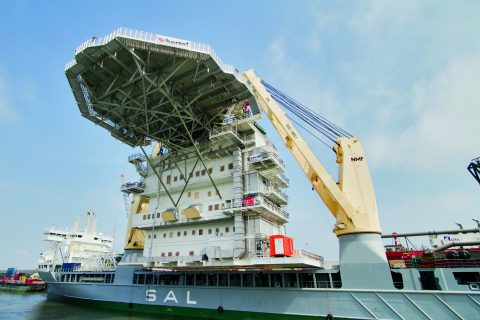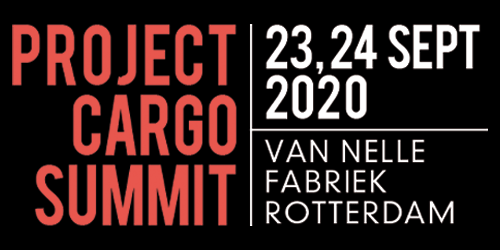Ports compete for breakbulk
 Antwerp remains the leading port for breakbulk in North-West Europe. Other ports such as Rotterdam and Zeeland Seaports are working very hard to increase their market shares in the sector. Volumes declined last year, but this is expected to change soon. The breakbulk market is highly differentiated, with cargo ranging from steel, non-ferrous metals, paper, wood and automotive to perishables and project cargo.
Antwerp remains the leading port for breakbulk in North-West Europe. Other ports such as Rotterdam and Zeeland Seaports are working very hard to increase their market shares in the sector. Volumes declined last year, but this is expected to change soon. The breakbulk market is highly differentiated, with cargo ranging from steel, non-ferrous metals, paper, wood and automotive to perishables and project cargo.
Besides traditional vessels, Ro/Ro ships are sometimes used and more and more breakbulk is moved in containers. This can make it difficult to assess the exact scope of the breakbulk sector. But statistics on pure breakbulk handling do exist though. According to the latest figures from the Port of Rotterdam Authority (PoR), the port of Antwerp handled 10.1 million tonnes of breakbulk in 2013; Rotterdam handled 4.7 million tonnes, Amsterdam 7.2 million tonnes and Zeeland Seaports 7.9 million tonnes. In the Hamburg-Le Havre range, a total of 46.9 million tonnes of breakbulk was handled. So Antwerp still accounts for more than a quarter of this market, despite declining volumes – which by the way affects almost all ports. Only Zeebrugge saw a slight increase. This is obviously attributable to the economic crisis, which is especially impacting the steel and automotive sector.
Outlook
The outlook for next year however is more optimistic. According to Wim Dillen, Senior Business Development Manager Marketing, Promotion and Commercial Relations at the Antwerp Port Authority, the Belgian port is determined to retain its leading position. “We have already held a strong position in this segment for several decades. There are various reasons for this. We or example have a very diverse range of terminal operators which handle breakbulk: seventeen terminals operated by thirteen different operators. This has resulted in very competitive pricing. Furthermore, our people are highly skilled, both in terms of operational management and pure port work. Antwerp’s port workers are known as highly productive employees with a very strong can-do attitude.”According to Dillen, Antwerp’s main advantage is its number of (semi) scheduled services; there are more than 250 sailings for general cargo each month. In 2008, this was still 220. “It is noteworthy that the number of services has in fact increased since the crisis. We offer eight times as many scheduled deepsea sailings as the second major port (Rotterdam). This fits in well with the current trend toward just-in-time and small stocks. Miss a departure and there will often be a next one within a week. In other ports, you sometimes have to wait a month. In addition, we have excellent connections with the hinterland.”
Dutch ports
But other ports are not idly standing by. The ports in Zeeland for example have always been strong in breakbulk, with transhipment terminals for wood, paper and metal. The offshore wind industry is also a growing market for Flushing. Amsterdam is doing fairly well too with more than seven million tonnes annually. In Rotterdam, breakbulk accounts for 4.7 million tonnes with the total throughput amounting to 450 million tonnes. As containerised breakbulk is not included, the actual volume in this market segment exceeds five million tonnes. Despite the modest share in relation to the total throughput, Rotterdam still considers breakbulk an important market. Robert Jan Timmers, Business Developer Breakbulk at PoR, explains: “It is a market which adds great value and is very important in terms of employment. The specialist activities require a certain quality of personnel, also regarding supplementary services such as floating cranes. Companies like Smit-Tak and Bonn & Mees can offer a contribution to the heavy-lift activities.” The port of Rotterdam has ten stevedoring companies which operate one or more breakbulk terminals (nineteen in total). Non-ferrous metals constitute the largest product group, followed by steel, heavy-lift and project cargo. Paper is also an important market and the fruit sector, for which the project Rotterdam Cool Port is being developed, is gaining in significance. Volumes in the breakbulk sector have developed in varying manners. The steel market was down last year and this was quite noticeable in the port of Antwerp. Non-ferrous metals, paper and project cargo are fairly stable. Timmers of the Port of Rotterdam Authority: “Aluminium is increasingly being used as a raw material instead of steel. This is quite evident in the production of cars. Everything is becoming lighter and lighter. As a result, non-ferrous steel is fairly stable. In the automotive sector, passenger cars in the upper segment are rapidly passing through the ports while the situation for smaller models in the lower segment has become extremely competitive.” Dillen of the Antwerp Port Authority foresees a growth in automotive this year; not only passenger cars, but all rolling stock. Increased containerisation is a clear trend in the breakbulk segment. More than twenty percent of trade. “Some cargo is simply too large and too heavy.” Timmers: “You can only split up parts, for example for a wind farm, so much. There is a trend toward introducing ever-larger break-bulk vessels. The heavy-lift shipping lines are increasingly targeting the offshore market. The ships are becoming more versatile, which means they can also be deployed at sea.”
Future plans
In the future, Rotterdam will continue to present itself as a base for storage and maintenance for the breakbulk and offshore markets. PoR is for example studying the feasibility of a location for storing really heavy cargo. Another focal point is the number of sailings. Timmers: “Together with the stevedoring companies, we want to look at new scheduled services by sea. Over the last year, several new ones have been introduced. The focus is on attracting more new services.” The port of Antwerp is primarily investing in added value. “More so than in volume,” says Dillen. “We recently invested in the further development of service centres for the steel industry. We now have seven of these small plants which offer such activities as custom-made steel and the cutting of non-ferrous metals. We also have service centres for the automotive industry that focus on the personalisation of cars. We are planning to invest 1.6 billion euros over the next twelve years. A significant percentage of this has been earmarked for breakbulk.”
This article was published in magazine: In the spotlight breakbulk
morenews
Project Cargo Summit 2024 registrations open
The time has come, we have opened registrations for this year’s edition of the Project Cargo Summit. As it was previously unveiled, the Port of Bilbao will be our host on September 17 and 18. There have been some changes since the announcement.
Project Cargo Summit 2024 programme takes shape
Excitement is building for the Project Cargo Summit 2024 in Bilbao, Spain! The dates are locked in (September 17th and 18th), the speaker list is filling up fast, and preparations are underway to make the “Project Cargo Summit 2024: Mega Cargo, Mega Solutions” an unforgettable event.
Project Cargo Summit goes to Bilbao
Following the successful outing in Bremen in 2023, ProMedia and its Project Cargo Summit team have turned their sights to a new adventure and have partnered with the Port of Bilbao. So for the 2024 edition of the Project Cargo Summit, project cargo, breakbulk and heavy lift industry specialists will gather in Bilbao for two… Read more ›
